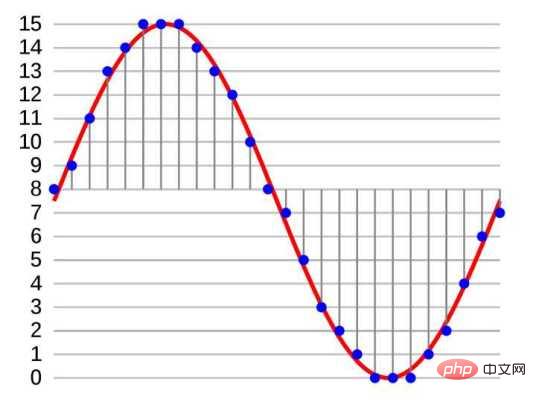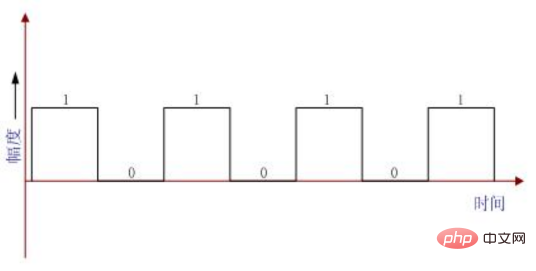
Analog signals refer to information represented by continuously changing physical quantities. The amplitude, frequency, or phase of the signal changes continuously with time, or within a continuous time interval, it represents the characteristic quantity of the information. A signal that can appear as any value at any instant. A digital signal refers to a signal in which the independent variable is discrete and the dependent variable is also discrete. The independent variable of this signal is represented by an integer, and the dependent variable is represented by a number among finite numbers; in computers, the size of digital signals is often represented by finite bits. binary number representation.

The operating environment of this tutorial: Windows 7 system, Dell G3 computer.
The information age has arrived without warning. We are surrounded by various signals all the time. The essence of signals is the physical quantity that represents messages (information). For example, in common sinusoidal electrical signals, if Different amplitudes, different frequencies, or different phases represent different messages (information). Data with signals as the carrier can represent any information in the real physical world, such as text symbols, images, etc. From the perspective of its specific expression, signals can be divided into: analog signals and digital signals.
What is an analog signal
Analog signal refers to information represented by a continuously changing physical quantity, the amplitude, or frequency, or The phase changes continuously with time, or within a continuous time interval, the characteristic quantity representing the information can appear as a signal of any value at any instant.
We usually call analog signals continuous signals, which can have infinitely many different values within a certain time range. Digital signals refer to signals that are discrete and discontinuous in value.

The main advantage of analog signals is their precise resolution, which in ideal cases has infinite resolution. Analog signals have higher information density than digital signals. Since there is no quantization error, it can describe the true values of physical quantities in nature as closely as possible.
Another advantage of analog signals is that analog signal processing is simpler than digital signal processing when achieving the same effect. The processing of analog signals can be implemented directly through analog circuit components (such as operational amplifiers, etc.), while digital signal processing often involves complex algorithms and even requires a specialized digital signal processor.
What is a digital signal
Digital signal refers to a signal in which the independent variable is discrete and the dependent variable is also discrete. The independent variable is represented by an integer and the dependent variable is represented by a number among finite numbers. In computers, the size of digital signals is often represented by binary numbers with limited bits.
Digital signals refer to using a set of special states to describe signals. Typically, signals are represented by the most common binary numbers. The fundamental reason why binary numbers are used to represent signals is that circuits can only Represents two states, namely, on and off of the circuit. In actual digital signal transmission, a certain range of information changes are usually classified as state 0 or state 1. The setting of this state greatly improves the anti-noise ability of digital signals. Not only that, in terms of confidentiality, anti-interference, transmission quality, etc., digital signals are better than analog signals, and they save more signal transmission channel resources.

Digital signals have many advantages. First of all, their anti-interference ability is particularly strong. They can not only be used in communication technology, but also in information processing technology. Fashionable High-definition TVs, VCDs, and DVD laser machines all use digital signal processing technology. Secondly, the electronic computers we use are all digital, and the signals they process are inherently digital signals. By using digital signals in communications, computers and communications can be easily combined, and the advantages of computers in processing information can be used in communications. For example, program-controlled digital switches are used in telephone communications, and computers are used to replace the operator's work. Not only are the connections fast and accurate, but they also occupy a small area and are highly efficient. They save a lot of labor and equipment, making telephone communications a qualitative leap. Thirdly, digital signals are easy to store. Nowadays, popular CDs, MP3 discs, VCDs, DVD video discs and computer optical discs all use digital signals to store information. In addition, digital communication is also compatible with the transmission of multiple types of information such as telephone calls, telegrams, data and images, and can transmit telephone, cable TV, multimedia and other information on the same line. Digital signals also facilitate encryption and error correction, and have strong confidentiality and reliability.
Because digital signals use two physical states to represent 0 and 1, their ability to resist interference from the material itself and environmental interference is much stronger than analog signals; in signal processing with modern technology, digital signals It plays an increasingly important role, and almost complex signal processing is inseparable from digital signals; in other words, as long as the solution to the problem can be expressed in mathematical formulas, computers can be used to process digital signals representing physical quantities.
In digital circuits, digital signals only have two states: 0 and 1. Its value is determined by the central value. Below the central value is specified as 0, and above it is specified as 1. Therefore, even if other interference signals are mixed in, As long as the value of the interfering signal does not exceed the threshold range, the original signal can be reproduced. Even if a bit error occurs because the value of the interfering signal exceeds the threshold range, as long as certain encoding technology is used, the erroneous signal can be easily detected and corrected. Therefore, compared with analog signals, digital signals have more advantages during transmission. High anti-interference ability, longer transmission distance, and small distortion amplitude.
Digital signals not only have high anti-interference during the transmission process, but can also be compressed to occupy less bandwidth, achieving the effect of transmitting more and higher video and other digital signals within the same bandwidth. . In addition, digital signals can also be stored in semiconductor memories and directly used for computer processing. If the image, text, video and other data processed by telephones, faxes, and televisions, as well as various other different forms of signals, are converted into digital pulses for transmission, it will also be conducive to forming a unified communication network and realizing the needs of people from all walks of life and the telecommunications industry today. The Integrated Services Digital Network (IS-DN) that we highly recommend. Thus providing people with new, more flexible and more convenient services. Because digital signals have the above-mentioned outstanding advantages, they are rapidly and have been widely used.
The difference between analog signals and digital signals
The main difference between analog signals and digital signals is: digital signals are discrete, while Analog signals are continuous.
Analog signals are represented by a series of continuously changing electromagnetic waves or voltage signals; digital signals are represented by a series of intermittent changing voltage pulses (for example, we can use a constant positive voltage to represent the binary number 1, and use a constant Negative voltage represents the binary number 0), or light pulses.
Digital signals only have two states: "0" and "1", while analog signals can be in any numerical state
Digital signals are digital. In computer systems, the CPU only recognizes " There are two numbers "0" and "1", so the digital signal needs to be represented by a binary number composed of "0" and "1". The analog signal is a continuously changing physical quantity, and its frequency, amplitude, and phase can continuously change with time.
For more related knowledge, please visit the FAQ column!
The above is the detailed content of What is an analog signal and what is a digital signal. For more information, please follow other related articles on the PHP Chinese website!




